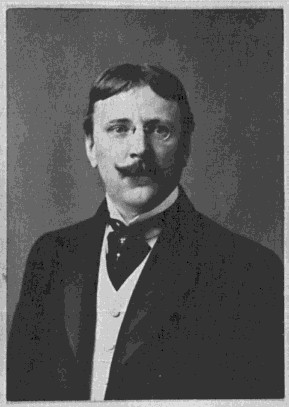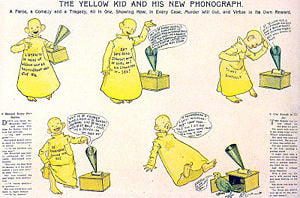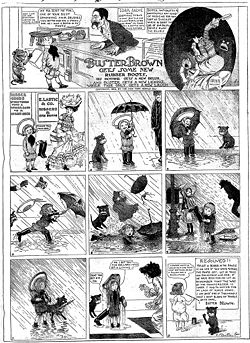Outcault, Richard Felton
({{Paid}}) |
|||
| Line 1: | Line 1: | ||
| − | {{Claimed}}{{Started}}{{Contracted}}{{Images OK}}{{Submitted}}{{Approved}}{{Paid}} | + | {{Claimed}}{{Started}}{{Contracted}}{{Images OK}}{{Submitted}}{{Approved}}{{Paid}}{{ce}} |
[[Category:Politics and social sciences]] | [[Category:Politics and social sciences]] | ||
[[Category:Communication]] | [[Category:Communication]] | ||
| Line 5: | Line 5: | ||
{{epname|Outcault, Richard Felton}} | {{epname|Outcault, Richard Felton}} | ||
| − | '''Richard Felton Outcault''' (January 14, 1863 - September 25, 1928) was an American [[comic strip]] scriptwriter, sketcher and painter in the late nineteenth and early twentieth centuries. Popularly known as R.F. Outcault, he is considered the inventor of the modern | + | '''Richard Felton Outcault''' (January 14, 1863 - September 25, 1928) was an American [[comic strip]] scriptwriter, sketcher and painter in the late nineteenth and early twentieth centuries. Popularly known as R.F. Outcault, he is considered the inventor of the modern comic strip and credited for making comic strips a lasting part of American society. Starting out as a technical illustrator for [[Thomas Edison]], Outcault later wrote articles for [[humor]] [[magazine]]s, which spawned his career in creating series of comic strips for the ''New York World'' and the ''New York Journal'' [[newspaper]]s. |
In 1895, Outcault introduced his popular comic strip ''Hogan's Alley'' featuring his famous "Yellow Kid" [[cartoon]] character. "The Yellow Kid" was the first recurring comic strip character, and his yellow colored nightshirt ushered in the era of colored comic strips. Outcault later introduced the popular cartoon ''Buster Brown'' in 1902. "The Yellow Kid" and "Buster Brown" cartoon characters eventually led to a line of products, toys, whiskey, and even shoes (Buster Brown Shoes). | In 1895, Outcault introduced his popular comic strip ''Hogan's Alley'' featuring his famous "Yellow Kid" [[cartoon]] character. "The Yellow Kid" was the first recurring comic strip character, and his yellow colored nightshirt ushered in the era of colored comic strips. Outcault later introduced the popular cartoon ''Buster Brown'' in 1902. "The Yellow Kid" and "Buster Brown" cartoon characters eventually led to a line of products, toys, whiskey, and even shoes (Buster Brown Shoes). | ||
Revision as of 15:45, 10 January 2008
Richard Felton Outcault (January 14, 1863 - September 25, 1928) was an American comic strip scriptwriter, sketcher and painter in the late nineteenth and early twentieth centuries. Popularly known as R.F. Outcault, he is considered the inventor of the modern comic strip and credited for making comic strips a lasting part of American society. Starting out as a technical illustrator for Thomas Edison, Outcault later wrote articles for humor magazines, which spawned his career in creating series of comic strips for the New York World and the New York Journal newspapers.
In 1895, Outcault introduced his popular comic strip Hogan's Alley featuring his famous "Yellow Kid" cartoon character. "The Yellow Kid" was the first recurring comic strip character, and his yellow colored nightshirt ushered in the era of colored comic strips. Outcault later introduced the popular cartoon Buster Brown in 1902. "The Yellow Kid" and "Buster Brown" cartoon characters eventually led to a line of products, toys, whiskey, and even shoes (Buster Brown Shoes).
Outcault was thus a key creator of the art of cartoons and comic strips. From fine art to political commentary and entertainment, these have played an important role in shaping the world as we know it.
Life
Richard Felton Outcault was born on January 14, 1863 in Lancaster, Ohio, the son of Jesse and Catherine Outcault, a wealthy family in [Lancaster]. He demonstrated an artistic talent at a young age, and in 1878 at the age of fifteen began studying art at the McMicken University School of Design in Cincinnati, Ohio. After studying there for three years, Outcault started working as a painter, yet soon found himself doing technical illustrations for Thomas Edison's Edison Laboratories. As a traveling artist for Edison, Outcault spent time in Paris, France while he was working at the World's Fair, and studied art in the Latin Quarter there. Outcault enjoyed his stay in Paris, and discovered a love for berets and capes.
When he returned to the United States, Outcault settled in New York City, and married Mary Jane Martin on Christmas Day 1890. They had two children, a boy and a girl, who Outcault would use as models for his "Buster Brown" & "Mary Jane" cartoon characters, the stars of his famous Buster Brown comic strip in 1902. In New York, he did freelance illustrator jobs and started working at Electrical World magazine, which stimulated his creativity and desire to produce comic strips. Outcault then proceeded to work for several different newspapers, where he created the famous cartoon characters "The Yellow Kid" and "Buster Brown."
In 1909, Outcault helped his son establish the Outcault Advertising Agency in Chicago, Illinois.
During his retirement, Outcault spent time painting portraits and landscapes.
Outcault died on September 25, 1928 in Flushing, New York at the age of 65.
Work
Outcault began his career in 1881 as a painter for the Hall Safe and Lock Company. In 1888, Thomas Edison hired Outcault to produce sophisticated technical illustrations for the Edison Laboratories this electric light display of the Exposition of the Ohio Valley and Middle Atlantic States in Cincinnati, Ohio. Edison was so impressed with the quality of Outcault's work, that Edison hired him to work in his West Orange, New Jersey]] facilities.
Outcault returned to New York City and wrote some humor sketches for the magazines such as Judge, Life, and Truth, but soon joined Joseph Pulitzer's New York World. Pulitzer used Outcault's comics in an experimental color supplement, using a single-panel color cartoon on the front page called Hogan's Alley, depicting an event in a fictional slum, was based on life in New York City. A character in the panel, The "Yellow Kid," was a bald kid named Mickey Dugan, a ghetto urchin living in the street, whose oversize nightshirt always had some kind of saying written on it. Hogan's Alley debuted May 5, 1895. The color yellow was picked because it was difficult to print at the time, and one of the foremen at the newspaper wanted to try yellow on the kid's nightshirt as a simple test. Outcault loved it and "The Yellow Kid" became a very successful comic strip in the Sunday newspapers. Average readers loved the cartoon, but the comic strip was not without controversy. New York elites were upset about the depiction of New York City slums in Hogan's Alley. Nonetheless, Outcault had the ingenuity and artistic talent which combined to depict situations in New York City which people could make people laugh. "The Yellow Kid" brought humor to the social and political concerns of the day. Hogan's Alley was the first recurring cartoon character in newspapers, and the success of "The Yellow Kid" ushered in the era of the colorful comics in newspapers.
The popularity of "The Yellow Kid" fueled a bitter battle between rival publishers over property rights. In October 1896, Outcault defected to William Randolph Hearst's New York Journal. The result of a lawsuit awarded the title "Hogan's Alley" to the World and "The Yellow Kid" to the Journal. The combination of Hearst's sensational journalism and the flashy bright "The Yellow Kid" cartoon character associated with his newspaper gave rise to the phrase "yellow journalism."
By 1901, Outcault had become weary of legal battles between the New York World and New York Journal so he created the comic strip Poor L'l Mose for the New York Herald. However, Outcault would be lured back to the Journal the following year.
In 1902, Outcault introduced Buster Brown, a mischievous boy dressed in Little Lord Fauntleroy style, and his dog Tige. The bulldog in the cartoon was created out of the likeness of Outcault's pet bulldog. Likewise, Outcault's own children were models for the "Buster Brown" and "Mary Jane" characters in the cartoon. The Buster Brown comic strip was featured weekly every Sunday until 1920 in the New York Journal.The strip and characters were very popular and Outcault eventually licensed the name for a number of consumer products, most notably Buster Brown shoes. For example, a hosiery manufacturer used the image of Buster Brown's dog Tige unsuccessfully trying to rip his socks in order to demonstrate the strength of his product. In the Journal, Outcault began experimenting with using multiple panels and speech balloons. Although he was not the first to use either technique, his use of them created the standard by which comics are measured. Many cartoonists would imitate Outcault's style and make it their own.
Outcault also created other comic strips during his career such as "Tommy Dodd" and "Ophelia" in the New York Herald in 1904, and another called "Bobby Tucker."
Because Outcault wisely protected his property rights to his cartoon characters, by 1905 he was earning more by selling cartoon character clothing and paraphernalia than he was making as a cartoonist. In 1909 Outcault partnered with his son to create the Outcault Advertising Agency, and by 1910 Outcault had accumulated a great deal of wealth, and retired to painting portraits and landscapes.
Legacy
Richard Felton Outcault was a gifted newspaper comic artist, painter, and sketcher, who combined his talents to pioneer the creation of the modern comic strip. He created the first recurring comic strip character in 1896, the "Yellow Kid" of Hogan's Alley. He also created Buster Brown in 1902. Although Outcault was not the first cartoonist to utilize dialog boxes or panel strips, he popular comic strips set the industry standard for "funny pages" in newspapers. His pioneering work demonstrated that comic strips could increase newspaper revenues and also spawn sales of associated toys and paraphernalia. Outcault created two of the most popular comic strip characters, "The Yellow Kid" and "Buster Brown." the "Yellow Kid" appeared in both the New York Herald and New York Journal newspapers from 1895-1989, and was incredibly successful. There were even lines of toys and products developed as a result. In 1902, Outcault created Buster Brown, a cartoon about a rich yet mischievous boy and his bulldog Tige. They were so popular that they also spawned many associated products. In 1904 Outcault sold the license for Buster and Tige to the Buster Brown Shoes Company, which became a very popular brand. Outcault's cartoon genius led to the birth and development of comic strips, which continue to influence our culture.
Publications
- Outcault, Richard Felton.1995.R.F. Outcault's the Yellow Kid: A Centennial Celebration of the Kid Who Started the Comics. Kitchen Sink Press. ISBN 0878163794 ISBN 978-0878163793
- Outcault, Richard Felton.1977.Buster Brown: An Original Compilation, First Collection in Full Continuity of a Complete Year from the Sunday Strip.Hyperion Pr. ISBN 088355660X ISBN 978-0883556603.
ReferencesISBN links support NWE through referral fees
- Campbell, W. Joseph. 2003, Yellow Journalism: Puncturing the Myths, Defining the Legacies. Praeger Paperback. ISBN 0275981134
- Harvey, Robert C., Brian Walker and Richard V. West. 1999. Children of the Yellow Kid: The Evolution of the American Comic Strip. University of Washington. ISBN 978-0295977782
External links
- Life & Times of Buster Brown Retrieved December 17, 2007.
- Bowling Green State University, Richard Felton Outcault, The Creator of the "Yellow Kid". Retrieved December 16, 2007.
- Lambiek.net Artists, R.F.Outcault Retrieved December 16, 2007.
- Olson, Richard D., R.F.Outcault, The Father of the American Sunday Comics, and the Truth About the Creation of the Yellow Kid. Retrieved December 16, 2007.
- Who2 biography of R.F. Outcault, R. F. Outcault, Cartoonist/Illustrator Retrieved December 16, 2007.
Credits
New World Encyclopedia writers and editors rewrote and completed the Wikipedia article in accordance with New World Encyclopedia standards. This article abides by terms of the Creative Commons CC-by-sa 3.0 License (CC-by-sa), which may be used and disseminated with proper attribution. Credit is due under the terms of this license that can reference both the New World Encyclopedia contributors and the selfless volunteer contributors of the Wikimedia Foundation. To cite this article click here for a list of acceptable citing formats.The history of earlier contributions by wikipedians is accessible to researchers here:
The history of this article since it was imported to New World Encyclopedia:
Note: Some restrictions may apply to use of individual images which are separately licensed.


